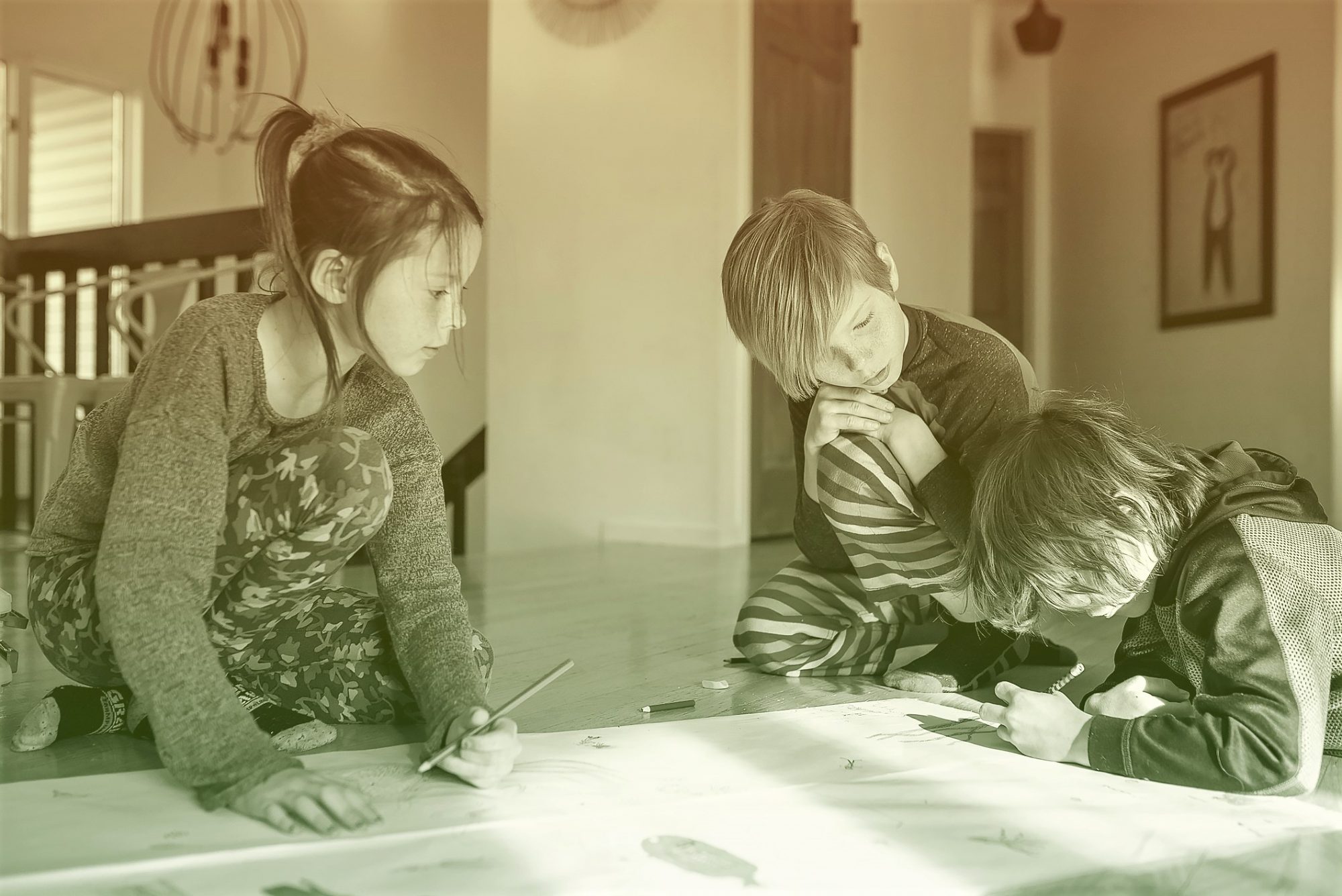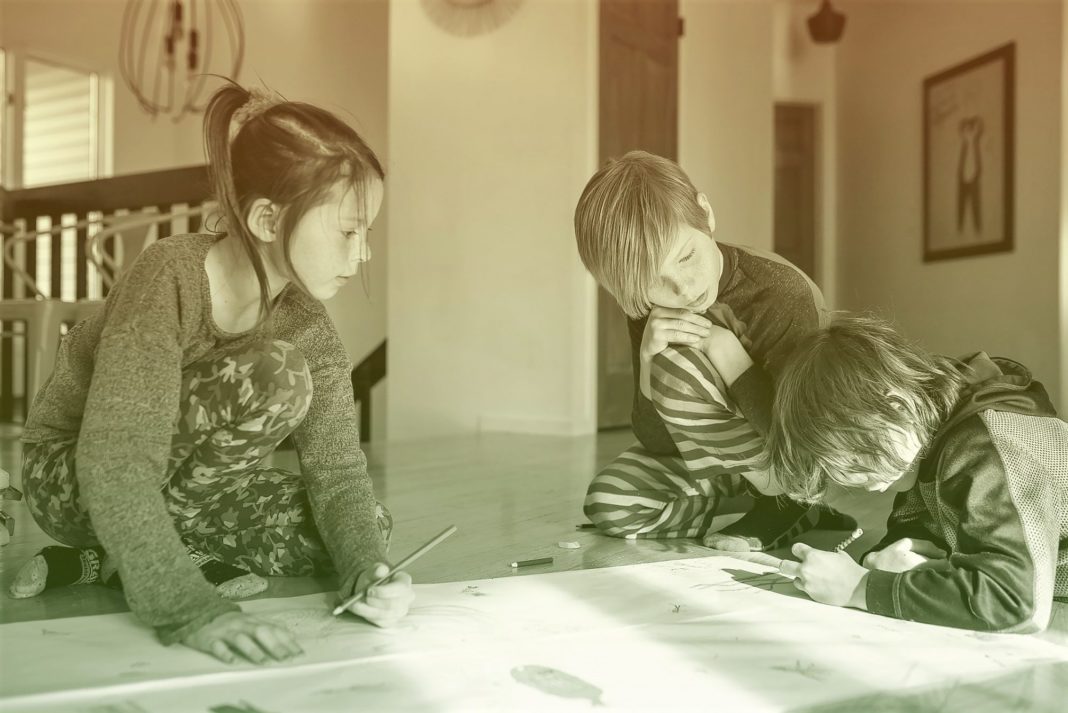The 2020 academic year has just begun for most K-12 students across the country and for millions of kids, that will mean remote learning at home. But for parents who have to work either inside or outside their home, remote learning poses some major anxiety. For affluent families, pandemic pods offer an easy way to buffer the transition from in-person to distance learning by hiring teachers and tutors and paying for oftentimes pricey curricula. But for the average American family who is struggling with the recession, pandemic pods can seem out of reach.
A pandemic pod, if you haven't heard your parenting pals talk about them yet, are small organized groups of families who enter in an agreement that they will work out a rotating schedule whereby each parent will teach one day a week, giving the other parents a chance to go to work without worry about daycare costs. The kids get to have social interactions and get out of their own homes by visiting their friends and learning together. But most importantly, if anyone gets sick, the pool of individuals is small enough to quickly and easily contain the virus. Typically, parents pool together resources and hire professional tutors who can cover a broad range of subjects, and kids who benefit from these arrangements don't typically fall behind in grades or academic skills.
"Pandemic pods are an interesting double-edged sword," says Jessica Lahey, a veteran teacher and author of The Gift of Failure: How the Best Parents Learn to Let Go So Their Children Can Succeed. "On one hand, if kids with the means to be out of school and educated elsewhere are not a part of the class census, that leaves room for kids who really need to be in class, and reduces the numbers in classrooms, keeping teachers safer."
Many affluent families seem to know this and have begun creating pandemic pods in every corner of the country. But, as Lahey goes on to point out, that might be leaving low-income kids at a huge disadvantage. "Learning pods may be great for the kids in the pod, but education is not about one kid or even a pod of them. Education should be about all kids, about a classroom community that works toward equity and inclusion," Lahey says. "Pandemic pods shift all the resources and opportunity toward wealthy kids and away from the kids who actually lose the most ground during summer and this COVID crisis, kids who won't be able to make up the ground they are losing as their wealthier peers advance."
So, how can low-income families create their own learning pods when the sheer cost of hiring tutors, tutoring services, or paying for homeschooling curriculums are simply not affordable?

Start With Your School District
If kids are given a remote learning option form their school district then parents can use the learning materials that teachers will be providing. That could include books and supplies, computers, lots of online resources, as well as virtual time with teachers and classmates. Be proactive and communicate with your child’s teachers to ask what materials you can bring into your home.
If remote learning is not an option in your school district but a group of less than affluent parents is still keen on creating a pod, then you can look up the academic standards for your school district and then use free resources to give kids the tools and instruction they need to hit their academic targets. There are hundreds of free online curriculums that parents can choose from as well as virtual tour experiences from art museums to national monuments and historic sites around the globe.
One site that offers free K-12 curriculum has a section that allows parents to type in their zip code and see virtual learning options from their local public schools. No family has to pay a tuition fee they just need basic supplies such as a computer and an internet connection.
Choosing Your Pod Families
Once you have a general idea of what your child will be doing you can start thinking about forming your pod of families. Remember, the best part of pods is that parents can create flexible learning schedules that don’t overlap with work schedules. Also, if someone should get sick, a pod is small enough to quarantine everyone and prevent the further spread of the virus. That said, there are few things that each family needs to agree too:
- Families should ideally agree to a plan about how much exposure they have to the general public. For example, not gathering in groups for celebrations, making sure to shop with masks on, and always adhere to social distancing.
- Families need to be clear about their work schedules and each parent needs to take a turn at teaching so that childcare and schooling are covered but also so that other parents can feel safe and secure knowing that while they work, their children are safe. If a parent has a strict schedule that doesn’t allow for teaching during regular school hours, get creative by moving some of the teaching duties to the weekend if possible.
- Once your pod is selected and everyone has agreed to the rules and schedule, parents should agree on how to share resources such as WiFi, physical materials, and space.
Create a List of Free Resources and Supplies
There are thousands of free resources online ranging from expected classroom work such as math, reading, and science to virtual tours of art and cultural museums all around the world. A few great places to start include:
Create a Space at Home for Learning
Not everyone can afford to create an entire room dedicated to learning. Luckily, as one veteran teacher shares, you don't have to!
"It can be really difficult to find a calm and quiet space at home in which to work (for teachers, too)! I think it's important for us to take the pressure off of ourselves-things won't be perfect, and that is okay," says Kate Foran, who teaches 4th grade at the Leroy Smith School in Winterport, Maine and was the recipient of the 2015 Teacher of the Year Award. "It is totally fine if your child's workspace is a corner of the kitchen table. The important thing is that you set clear expectations and, if possible, try to set your workspace up away from distractions like television."
If your pod is going to learn around your kitchen table then make sure it is clear of any distractions and have everything you need for your lessons handy.
"I use baskets in students' desks where all of their materials are held, so I know they shouldn't have to get up and interrupt a lesson or their work time to get supplies," says Foran. "I know that kids can get their own materials, but this way they don't need to interrupt their flow. It doesn't need to be anything fancy-a gallon-sized freezer bag with all of a kid's materials would work great for this."
Stick to a Schedule and Have a Plan, Even If Everything Goes Wrong
Many of us have fresh memories of how stressful remote learning was last year. With some planning and support from your pod pals, you can try to alleviate some of the stress that you may have felt in trying to finish school back in April and May. But if you find that your 2020 at-home school isn't going as planned then chill.
"This is a stressful time for everyone, and maybe it's time to focus more on social-emotional skills, coping, and stress reduction than on math facts," Lahey points out. "Help kids find ways (and the words) to manage their stress, including play, meditation, walks, and talking about when—not if—things will be better."
Just remember, this pandemic might feel like it's never going to end but it will and a new normal will take over. In the meantime, keeping your family safe, healthy, and as happy as possible is all we can really do. Take a deep breath, you got this.


